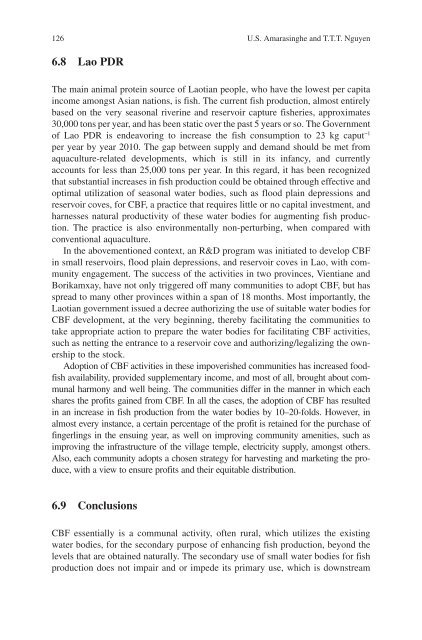Success Stories In Asian Aquaculture - Library - Network of ...
Success Stories In Asian Aquaculture - Library - Network of ...
Success Stories In Asian Aquaculture - Library - Network of ...
- No tags were found...
Create successful ePaper yourself
Turn your PDF publications into a flip-book with our unique Google optimized e-Paper software.
126 U.S. Amarasinghe and T.T.T. Nguyen6.8 Lao PDRThe main animal protein source <strong>of</strong> Laotian people, who have the lowest per capitaincome amongst <strong>Asian</strong> nations, is fish. The current fish production, almost entirelybased on the very seasonal riverine and reservoir capture fisheries, approximates30,000 tons per year, and has been static over the past 5 years or so. The Government<strong>of</strong> Lao PDR is endeavoring to increase the fish consumption to 23 kg caput −1per year by year 2010. The gap between supply and demand should be met fromaquaculture-related developments, which is still in its infancy, and currentlyaccounts for less than 25,000 tons per year. <strong>In</strong> this regard, it has been recognizedthat substantial increases in fish production could be obtained through effective andoptimal utilization <strong>of</strong> seasonal water bodies, such as flood plain depressions andreservoir coves, for CBF, a practice that requires little or no capital investment, andharnesses natural productivity <strong>of</strong> these water bodies for augmenting fish production.The practice is also environmentally non-perturbing, when compared withconventional aquaculture.<strong>In</strong> the abovementioned context, an R&D program was initiated to develop CBFin small reservoirs, flood plain depressions, and reservoir coves in Lao, with communityengagement. The success <strong>of</strong> the activities in two provinces, Vientiane andBorikamxay, have not only triggered <strong>of</strong>f many communities to adopt CBF, but hasspread to many other provinces within a span <strong>of</strong> 18 months. Most importantly, theLaotian government issued a decree authorizing the use <strong>of</strong> suitable water bodies forCBF development, at the very beginning, thereby facilitating the communities totake appropriate action to prepare the water bodies for facilitating CBF activities,such as netting the entrance to a reservoir cove and authorizing/legalizing the ownershipto the stock.Adoption <strong>of</strong> CBF activities in these impoverished communities has increased foodfishavailability, provided supplementary income, and most <strong>of</strong> all, brought about communalharmony and well being. The communities differ in the manner in which eachshares the pr<strong>of</strong>its gained from CBF. <strong>In</strong> all the cases, the adoption <strong>of</strong> CBF has resultedin an increase in fish production from the water bodies by 10–20-folds. However, inalmost every instance, a certain percentage <strong>of</strong> the pr<strong>of</strong>it is retained for the purchase <strong>of</strong>fingerlings in the ensuing year, as well on improving community amenities, such asimproving the infrastructure <strong>of</strong> the village temple, electricity supply, amongst others.Also, each community adopts a chosen strategy for harvesting and marketing the produce,with a view to ensure pr<strong>of</strong>its and their equitable distribution.6.9 ConclusionsCBF essentially is a communal activity, <strong>of</strong>ten rural, which utilizes the existingwater bodies, for the secondary purpose <strong>of</strong> enhancing fish production, beyond thelevels that are obtained naturally. The secondary use <strong>of</strong> small water bodies for fishproduction does not impair and or impede its primary use, which is downstream
















